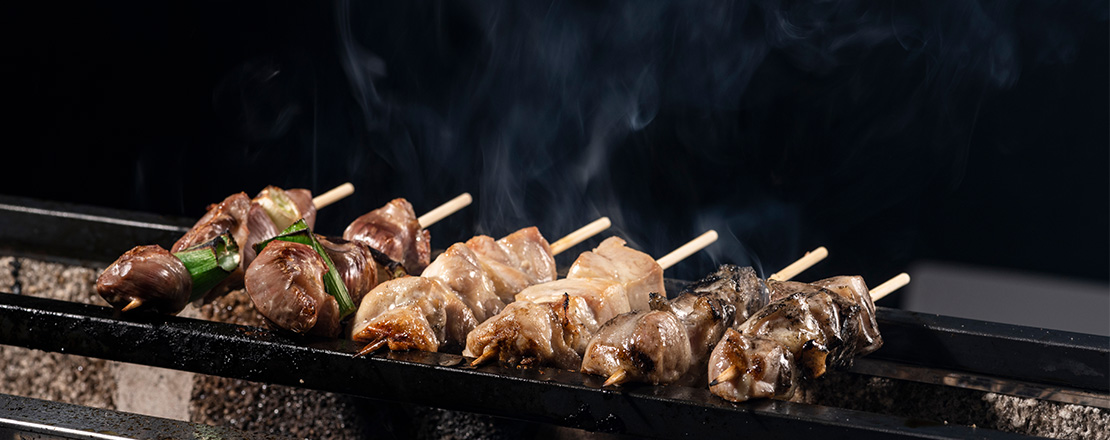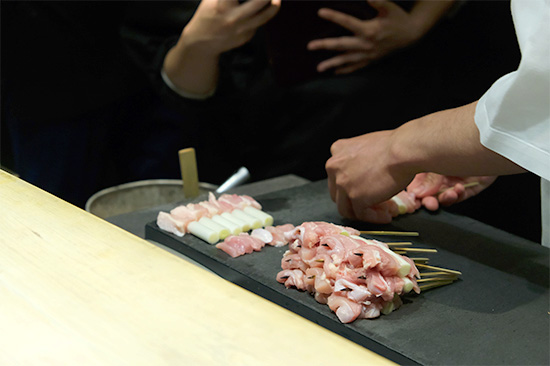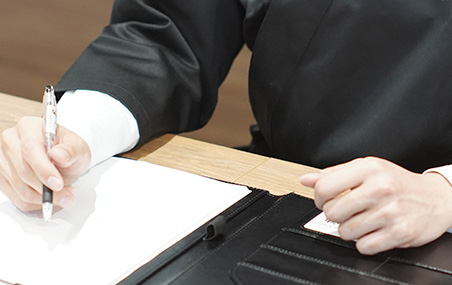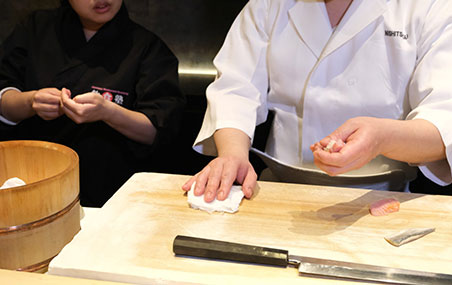First, students will repeatedly practice the handling of chicken without organs, and then they will handle whole chicken with organs under the supervision of an instructor certified as a poultry processing sanitation supervisor. In addition, students will learn the skills of a high-price yakitori restaurant through careful skewering, charcoal handling, and the basics of Japanese cuisine. As part of the course, students will learn how to prepare and operate a real shop, so they will also learn how to behave at the counter.


Types of knives, carrying precautions, how to use them according to different cooking, handling, and sharpening
How to handle basic utensils used in a sushi restaurant, such as a sushi table, colander, grater, etc.
How to make yakitori sauce and combined seasonings
Learn how to keep chicken fresh and how to manage it, and how to cut chicken from a whole chicken into various parts and practice the repetition of this method.
Characteristics of each type of charcoal and practical skills on how to extinguish from lighting to extinguishing
Type of rice, how to cook
Seasonal types, characteristics, management, and cutting methods
How to make soup stock from different ingredients (kombu, chicken) and basic serving methods
Basic cooking using the five methods (cutting, steaming, boiling, baking, and deep frying)
Basic lecture on beverages served in yakitori restaurants and how to handle them.
Practical mock sales skills (customer service, order taking, baking, serving, and checkout) in a restaurant adjacent to the classroom.

Basic knowledge and comparison of parent chickens, broilers, and branded chickens; handling various types of chickens; handling of gutted chickens and chickens with internal organs
Types of skewers and skewering
Basic knowledge and handling of pork and beef, basic fish fillet
Theory and practical skills on how to prepare kaiseki and kappo cuisine
Lecture by the general manager of a popular yakitori restaurant on his hardships and commitment to the management of his restaurant
A Marketing Lecture on Creating a Restaurant that will not go out of business
The actual management of the restaurant while being in charge of the kitchen, cooking assistance, and hall service, in order

Biography
He worked as a Japanese and kaiseki chef for 11 years at “Arima Grand Hotel” and “Japanese Cuisine Yugi” in Nakanobo Co. Based on this experience, he has been a cooking instructor of Yakitori, Japanese cuisine, and sushi for about 30 years at Kobe International Cooking and Confectionery College and University for Restaurants. He has experience managing Japanese and sushi restaurants.
He holds a chef’s license, a specialty in Japanese, sushi, and noodle cuisine, a poultry processing sanitation supervisor, and a blowfish license. In addition, he is also certified in Japanese cuisine dining etiquette, tea ceremony Urasenke, sencha-do, and flower arrangement Kofu-ryu.
What he values in undertaking lecturer at the Japanese Restaurant Academy
I will constantly intake new information and transmit the joy of cooking to those who have decided to develop their skills and knowledge to become a chef.
Message to those who are thinking about joining the school
Taking on a new challenge is a wonderful thing. We are here to help you realize your aspirations, goals, and dreams. We will guide you to become a successful chef through an intense experience and learning knife techniques, heat application, seasoning balance, knowledge, science, theory, and food culture. Have fun learning!
| Duration of the course | 2 months | January 5, 2023 | 2023年1月5日 |
|---|---|---|---|
| Admission fee | ¥110,000 (tax included) | Tuition fee | ¥660,000 (tax included) |
| Other actual expenses | approx. 50,000 yen (instructional book, uniform, hat, knife set) |
|---|

Please apply by form, LINE, or by phone. We recommend LINE(https://lin.ee/VB8vAf5), which is a relatively easy way to contact us.
TEL:03-5989-0410

You can tour the school building and the restaurants. The school building is conveniently located at a 5-minute walk from Shinjuku Station. After the tour, an advisor will give you a detailed explanation of the school and its courses, if desired.

Please submit an application form for admission.You will receive an email with course confirmation and payment instructions.

Enrollment will begin upon completion of the enrollment process and payment of the course fee. The timing of the start of the course varies depending on the course.